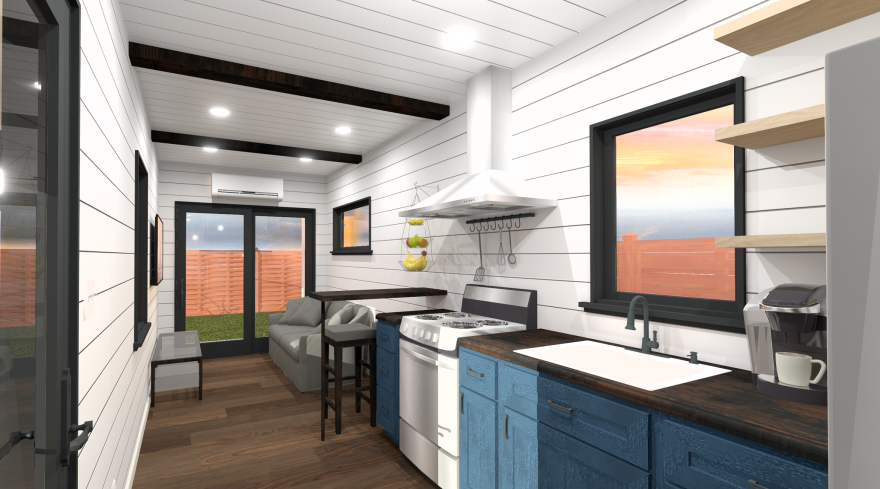TIMNATH, Colo. — New homes dot most street corners of this growing town east of Fort Collins, where the starting sale price is over half a million dollars — and rising. Prices for lumber, steel and labor have doubled in the past few years.
The cost to tap into the town’s water supply alone is $35,000.
But just down the street from one construction site lies a dirt lot full of metal shipping containers — the kind used to transport things like cars, electronics and food on cargo ships. Instead of loading the containers up, a small crew is transforming them into one-bedroom homes aimed at filling a growing need for affordable housing in Northern Colorado.
Danny Crisafulli calls them “FlexHomes.” The 320 square foot spaces are big enough to fit a bedroom, bathroom, kitchen and living room with a couch.
The metal containers can be completely converted to houses on-site, then hauled anywhere and cemented to the ground. Each home goes for about $89,000, Crisafulli says, which is far less than a traditional house or even the cost to build a single apartment unit.
Crisafulli is a local realtor who nowadays helps manage this small business and is tackling Northern Colorado’s housing crunch one shipping container at a time. That’s the model of Pivot Structures, converting used containers into prefabricated housing that can be plopped down in a backyard or vacant lot. The new venture started amid the pandemic and plans to expand in the coming year.
“We have a housing crisis,” Crisafulli said while walking through the interior of one container’s bedroom, which is big enough to fit a queen-sized bed. “Are we going to solve all of those problems? No. But we can solve some of those problems.”

Northern Colorado is short thousands of housing units, according to Crisafulli, and the Common Sense Institute estimates the number is over 175,000 statewide — a number that various people and local governments view as too low or too high. Either way, the deficit is contributing to double-digit percent price increases across the state and stressing out working class families looking for a place to live.
The shortage is so bad, some communities have considered declaring a state of emergency.
The median sale price for a single family home in the state hit $530,000 in June — an eye-popping 24% increase over last year, according to the Colorado Association of Realtors. After dipping in 2020, rents are spiking too. The average two-bedroom unit in Aurora, for example, rose to $1,670 in July.
That’s a record 12.2% increase in one year, according to Apartment List.
The slow and expensive pace of traditional building isn’t the sole source of the problem, but many experts believe that diversifying the types of home builders in the state — especially those who use nontraditional and prefabricated building models — could help boost supply and cool off price increases.
This past legislative session, partly thanks to American Rescue Plan funding, state lawmakers passed hundreds of millions of dollars in bills aimed at ramping up construction of new types of affordable housing. Gov. Jared Polis signed them all.
“There’s always a way out of it,” said Evelyn Lim, a housing researcher with the Common Sense Institute. “But we need people to act now with a sense of urgency because in order for us to attack this deficit, we really have to start implementing some of these ideas.”

Crisafulli, the Fort Collins realtor, had his own moment of realization when he started looking into building a home for his family a few years ago. He looked into prefabricated construction, which is typically cheaper, but found it was more expensive than traditional, or “stick-frame” building. He learned that many prefab builders in Colorado used middlemen to build the structures, he said.
Friends referred him to Jeff Hanesworth, a local home builder who, on a whim, had purchased several used shipping containers from a supplier in Arizona to try to convert them into backyard office and studio spaces. He stored them on a lot near his home in Timnath.
Then the pandemic hit. While some parts of the economy tanked, the real estate market in Northern Colorado thrived. Buyers swarmed the few listings available, pushing the median sale price for a home in Fort Collins over the $500,000 mark for the first time ever.
Along with a third partner, the Pivot team took notice and grew their idea. They drew up plans for one- and two-bedroom homes made out of the long, metal boxes. The interior design was borrowed from the layout of RVs and tiny houses.
By using a shipping container as the main frame, the builders found they could ditch most of the lumber and steel used in traditional homebuilding, shaving tens of thousands of dollars off the cost.
“We need real-world solutions,” said Hanesworth. “The cost of a traditional building is through the roof. This is one way for us to be more innovative and flexible.”


The team put their one-bedroom homes on the market last fall. So far, they’ve only sold one, which they plan to deliver later this summer. But they’ve gotten “a lot” of buyer interest. It is slow going, Crisafulli says, mostly due to strict local zoning laws that make it difficult for existing homeowners to place the structures on their property and rent them out.
In those cases, which the Pivot team sees as a key market, local governments classify their FlexHomes as Accessory Dwelling Units, or ADUs. They also go by other nicknames, like “granny flats” and “backyard cottages.”
Most municipalities have strict requirements regulating everything from the size of ADUs to their appearance. Homeowners associations can ban them. City and town development fees, which can run into the tens of thousands of dollars, are also a deterrent for some customers.
“It’s really easy for people to, when they hear about the idea, they’ll go ‘This is awesome,’” Crisafulli said. “But taking the next step is a totally different scenario.”
Pivot and its customers could soon get relief. Many local governments in Northern Colorado are looking at loosening their restrictions in the coming years to help boost housing stock.
Loveland recently reduced minimum lot sizes, slashed $24,000 in impact fees for new ADUs and removed a requirement that an owner must reside on the same property. As a result, applications jumped.
Greeley is set to adopt new zoning rules in September that allow most single family residential homes to build them.
Earlier this year, Fort Collins passed a strategic housing plan that calls for allowing ADUs by right in all residential zoning districts, reducing water tap and other development fees and considering a new grant program that encourages their construction. The recommendations have yet to be adopted.
“I think that the philosophy is changing in Northern Colorado,” said Susan Beck-Ferkiss, Fort Collins’ social policy and housing programs manager, who helped draft the city’s new strategic plan. “We’re realizing accessory dwelling units can be beneficial to our ability to give options to our residents that they're asking for.”

What’s unclear is how much the changes will add to the local housing supply. And the topic can be controversial.
When the Denver suburb of Englewood first moved to allow ADUs in 2019, some residents pushed back, citing fears of increased density that could cause friction between neighbors and change the city’s culture.
But the looser rules haven’t had much of an impact. Only seven households have applied to build ADUs since then, according to the city’s planning department.
Similar efforts in California and Oregon have led to a boost in ADU construction, but the numbers have only made a dent in the state’s overall housing affordability challenges.
“You’re adding to the housing stock for sure,” Lim, the housing researcher said. “Now, is it the panacea to the problem? Probably not.”
Earlier this year, Colorado legislators approved a $550 million spending package aimed at propping up affordable housing efforts. The bill, which Gov. Polis signed in June, creates a new state treasury fund with American Rescue Plan dollars focused on “programs or services that address housing insecurity, lack of affordable housing, or homelessness.” Polis also overturned a decades-old Colorado Supreme Court ruling that prevented local governments from requiring affordable rental units in new development projects.
“Local governments have been begging us for tools,” Sen. Julie Gonzales, a Democrat and prime sponsor of the legislation, said during the bill signing. “This bill is a tool.”
Crisafulli welcomes those initiatives, even if changes come at a slow pace. But he thinks there’s room for his small-scale shipping container model to make an impact on a problem that many view as overwhelming.
“You can add 200 apartment units with one national developer at one location,” he said. “But maybe it’s better to add 200 units across 200 lots where local homeowners are hiring individual construction crews and then keeping that rental income local as opposed to it being dispersed throughout the entire United States.”

Lim considers Pivot’s idea “promising,” especially when it comes to boosting the number of ADUs in the state. It could also allow seniors to “age in place” and potentially increase the value in property owners’ homes, “which would benefit the community overall,” she said.
Expanding into more Northern Colorado communities is Pivot Structures’ next step. Crisafulli and Hanesworth have been meeting with local planning departments and hope to find ways to make their units more affordable and accessible for residents.
They have plans to start offering larger-size homes. Later this year, they plan to build a two-bed, two-bath spec house on a lot in west Fort Collins. The team wants to “work out the kinks,” before offering it to the public, Crisafulli said.
Pivot also sees opportunities in public and philanthropic sectors, Hanesworth said. The team has met with local governments to talk about creating transitional housing options for people experiencing homelessnes. They’ve also met with veterans organizations to talk about creating a “veterans village” concept that’s been done in other areas with high rates of veteran homelessness.
Once local building restrictions loosen, Hanesworth thinks the market for shipping container living spaces will boom. The company has already leased out a larger manufacturing space in the nearby town of Severance, where they expect to ramp up production this fall.
“There’s such a huge need,” Hanesworth said. “There are so many builders out there doing the same thing, and we decided to move to something a little more inspirational.”





